
Bernard of Clairvaux, O. Cist., venerated as Saint Bernard, was an abbot, mystic, co-founder of the Knights Templar, and a major leader in the reform of the Benedictines through the nascent Cistercian Order.

Barlaam and Josaphat, also known as Bilawhar and Budhasaf, are Christian saints. Their life story was based on the life of the Gautama Buddha, who historically lived several centuries before Jesus. Their story tells of the conversion of Josaphat to Christianity. According to the legend, an Indian king persecuted the Christian Church in his realm. After astrologers predicted that his own son would some day become a Christian, the king imprisoned the young prince Josaphat, who nevertheless met the hermit Saint Barlaam and converted to Christianity. After much tribulation the young prince's father accepted the Christian faith, turned over his throne to Josaphat, and retired to the desert to become a hermit. Josaphat himself later abdicated and went into seclusion with his old teacher Barlaam.

The Divine Comedy is an Italian narrative poem by Dante Alighieri, begun c. 1308 and completed around 1321, shortly before the author's death. It is widely considered the pre-eminent work in Italian literature and one of the greatest works of Western literature. The poem's imaginative vision of the afterlife is representative of the medieval worldview as it existed in the Western Church by the 14th century. It helped establish the Tuscan language, in which it is written, as the standardized Italian language. It is divided into three parts: Inferno, Purgatorio, and Paradiso.

Marie de France was a poet, likely born in France, who lived in England during the late 12th century. She lived and wrote at an unknown court, but she and her work were almost certainly known at the royal court of King Henry II of England. Virtually nothing is known of her life; both her given name and its geographical specification come from manuscripts containing her works. However, one written description of her work and popularity from her own era still exists. She is considered by scholars to be the first woman known to write francophone verse.

The Ninety-five Theses or Disputation on the Power and Efficacy of Indulgences is a list of propositions for an academic disputation written in 1517 by Martin Luther, then a professor of moral theology at the University of Wittenberg, Germany. The Theses is retrospectively considered to have launched the Protestant Reformation and the birth of Protestantism, despite various proto-Protestant groups having existed previously. It detailed Luther's opposition to what he saw as the Roman Catholic Church's abuse and corruption by Catholic clergy, who were selling plenary indulgences, which were certificates supposed to reduce the temporal punishment in purgatory for sins committed by the purchasers or their loved ones.

Mary, Queen of the World Cathedral or in full Mary, Queen of the World and St. James the Great Cathedral is a minor basilica in Montreal, Quebec, Canada, and the seat of the Roman Catholic Archdiocese of Montreal. It is the third largest church in Quebec after Saint Joseph's Oratory and the Basilica of Sainte-Anne-de-Beaupré east of Quebec City. The building is 101 m (333 ft) in length, 46 m (150 ft) in width, and a maximum height of 77 m (252 ft) at the cupola, the diameter of which is 23 m (75 ft).

In the teaching of the Catholic Church, an indulgence is "a way to reduce the amount of punishment one has to undergo for (forgiven) sins". The Catechism of the Catholic Church describes an indulgence as "a remission before God of the temporal punishment due to sins whose guilt has already been forgiven, which the faithful Christian who is duly disposed gains under certain prescribed conditions…"

Saint Giles, also known as Giles the Hermit, was a hermit or monk active in the lower Rhône most likely in the 7th century. Revered as a saint, his cult became widely diffused but his hagiography is mostly legendary. A town that bears his name grew up around the monastery he purportedly founded, which became a pilgrimage centre and a stop on the Way of Saint James. He is traditionally one of the Fourteen Holy Helpers.

Saint Eustace is revered as a Christian martyr. According to legend, he was martyred in AD 118, at the command of emperor Hadrian. Eustace was a pagan Roman general, who converted to Christianity after he had a vision of the cross while hunting. He lost all his wealth, was separated from his wife and sons, and went into exile in Egypt. Called back to lead the Roman army by emperor Trajan, Eustace was happily reunited with his family and restored to high social standing, but after the death of Trajan, he and his family were martyred under Hadrian for refusing to sacrifice to pagan Roman gods.
Anglo-Norman literature is literature composed in the Anglo-Norman language and developed during the period of 1066–1204, as the Duchy of Normandy and the Kingdom of England were united in the Anglo-Norman realm.

St Patrick's Purgatory is an ancient pilgrimage site on Station Island in Lough Derg, County Donegal, Ireland. According to legend, the site dates from the fifth century, when Christ showed Saint Patrick a cave, sometimes referred to as a pit or a well, on Station Island that was an entrance to Purgatory. Its importance in medieval times is clear from the fact that it is mentioned in texts from as early as 1185 and shown on maps from all over Europe as early as the fifteenth century. It is the only Irish site designated on Martin Behaim's world map of 1492.
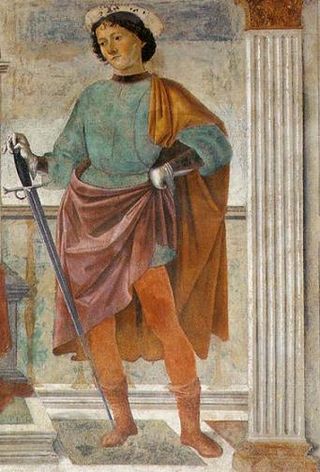
Saint Julian the Hospitaller is a saint venerated in the Roman Catholic Church and Eastern Orthodox Church. He is the patron saint of the cities of Ghent, Belgium; Saint Julian's, Malta; and Macerata, Italy.
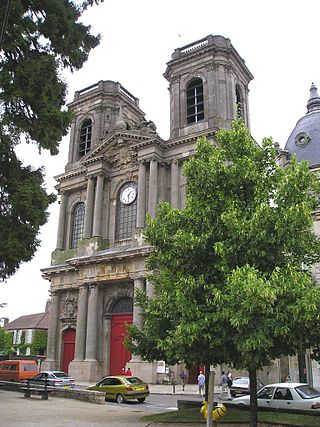
The Diocese of Langres is a Latin Church diocese of the Catholic Church comprising the département of Haute-Marne in France.

Saint Patrick was a fifth-century Romano-British Christian missionary and bishop in Ireland. Known as the "Apostle of Ireland", he is the primary patron saint of Ireland, the other patron saints being Brigid of Kildare and Columba. Patrick was never formally canonised by the Catholic Church, having lived before the current laws it established for such matters. He is venerated as a saint in the Catholic Church, the Lutheran Church, the Church of Ireland, and in the Eastern Orthodox Church, where he is regarded as equal-to-the-apostles and Enlightener of Ireland.

The idea of purgatory has roots that date back into antiquity. A sort of proto-purgatory called the "celestial Hades" appears in the writings of Plato and Heraclides Ponticus, among many other Classical writers. This concept is distinguished from the Hades of the underworld described in the works of Homer and Hesiod. In contrast, the celestial Hades was understood as an intermediary place where souls spent an undetermined time after death before either moving on to a higher level of existence or being reincarnated back on Earth. Its exact location varied from author to author: Heraclides Ponticua thought it was in the Milky Way; the Academicians, the Stoics, Cicero, Virgil, Plutarch, and Hermetical writings situated it between the Moon and the Earth or around the Moon; while Numenius and the Latin Neoplatonists thought it was located between the sphere of the fixed stars and the Earth.
La Vie Seinte Audree is a 4625-line hagiography detailing the life, death, and miracles of Saint Audrey, an Anglo-Saxon saint from Ely, Cambridgeshire in Britain.
Saint Judoc, otherwise known as Jodoc, Joyce or Josse was a seventh-century Breton noble considered to be a saint. Judoc was a son of Juthael, King of Brittany. He renounced his wealth and position to become a priest and lived alone for the rest of his lifetime in the coastal forest near the mouth of the River Canche.
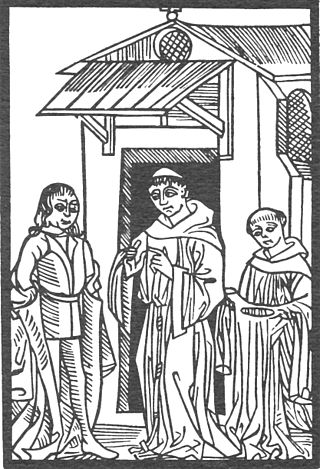
Tractatus de Purgatorio Sancti Patricii is a Latin text written about 1180–1184 by a monk who identified himself as H. of Saltrey. The author is traditionally known as Henry, though this was an insertion and invention of Matthew of Paris and has been contested in the influential work of historian Jacques le Goff. H de Saltrey was a Cistercian in Huntingdonshire.
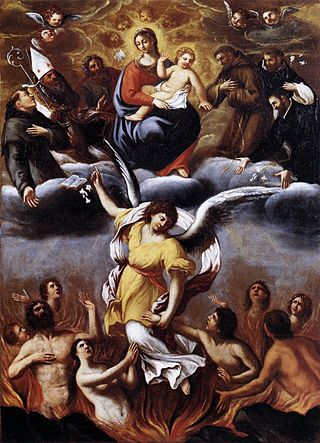
Purgatory is a passing intermediate state after physical death for purifying or purging a soul. A common analogy is dross being removed from metal in a furnace.
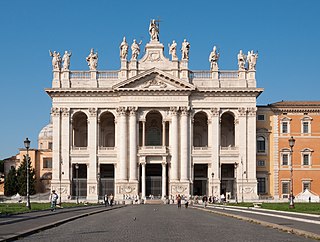
The Latin Church is the largest autonomous particular church within the Catholic Church, whose members constitute the vast majority of the 1.3 billion Catholics. The Latin Church is one of 24 churches sui iuris in full communion with the pope; the other 23 are collectively referred to as the Eastern Catholic Churches, and have approximately 18 million members combined.

















